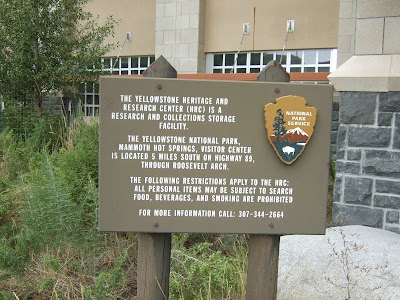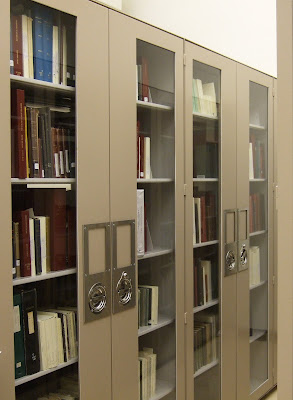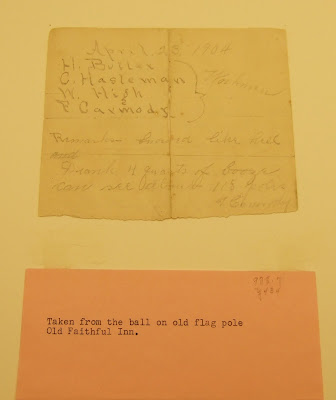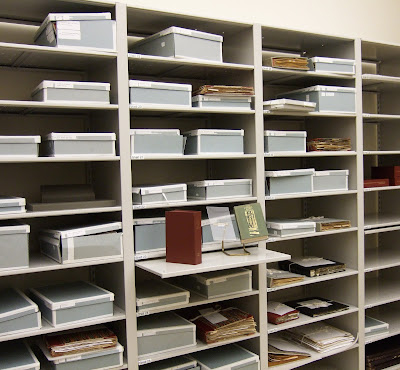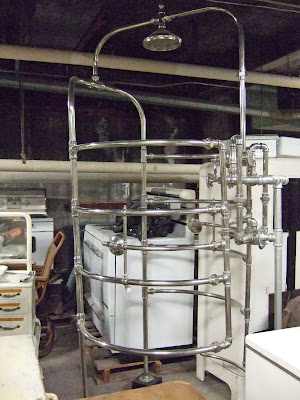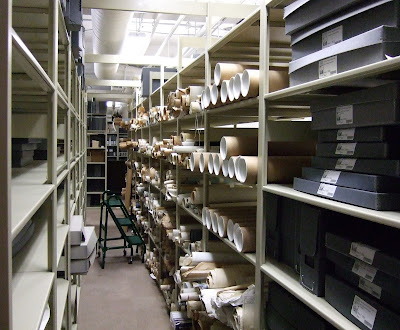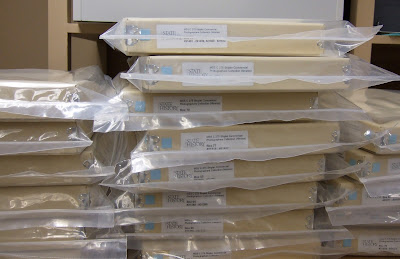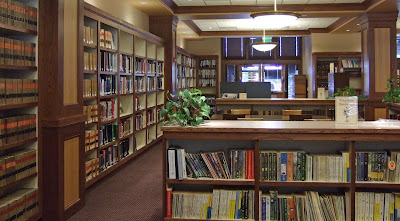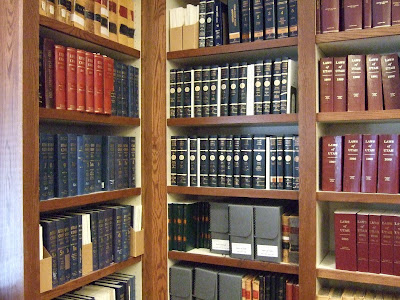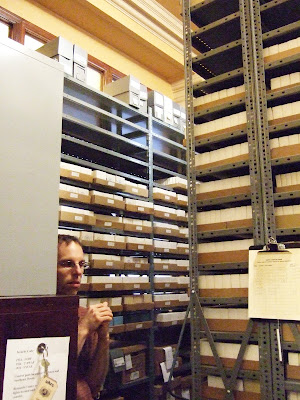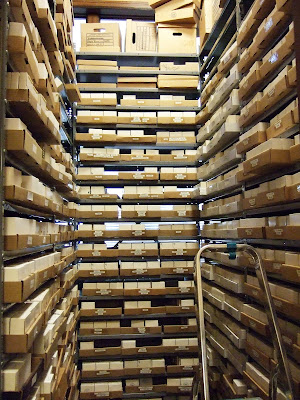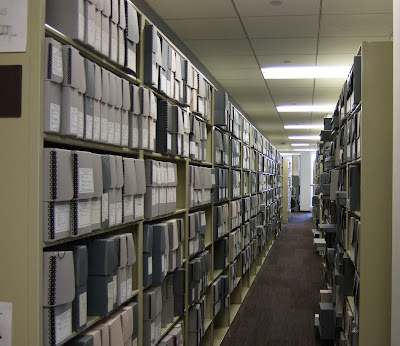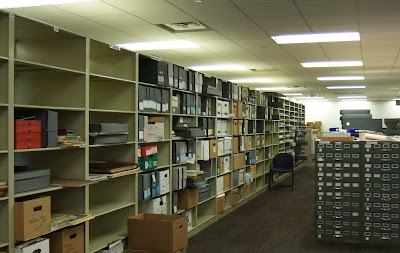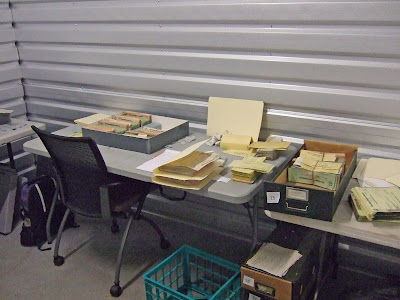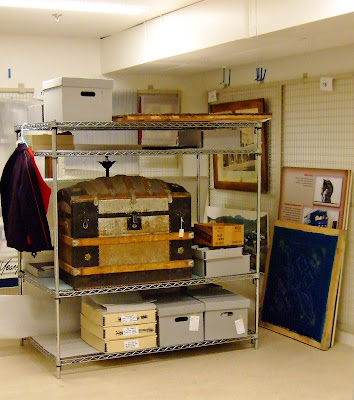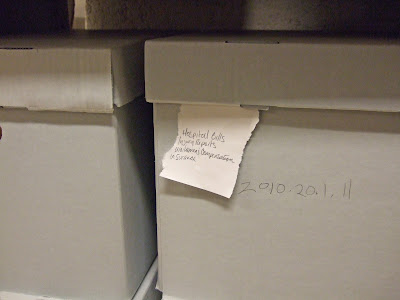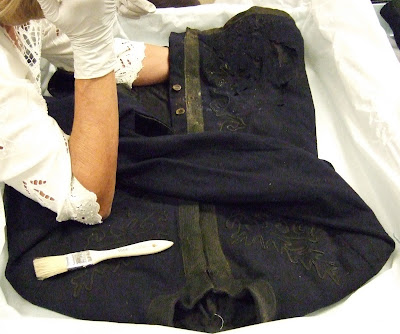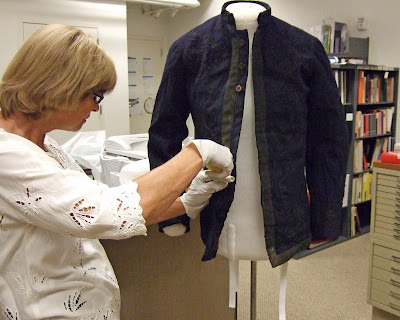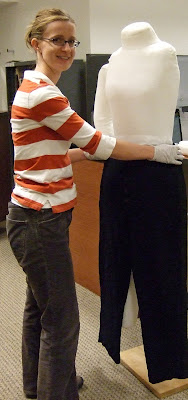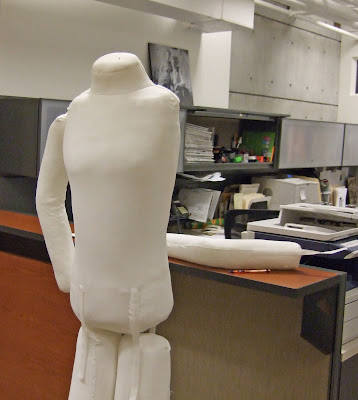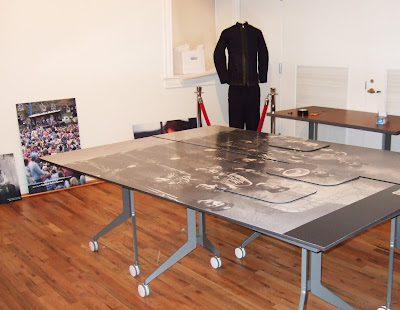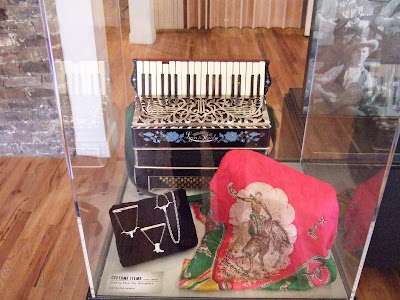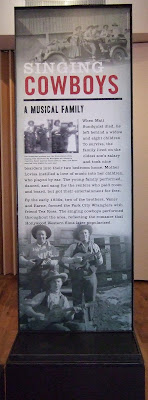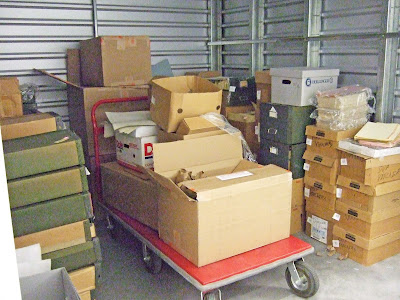November 29, 2010 update: This morning, Gina from the Utah State Archives took the time to send me an email that corrected some of my misunderstandings. Consequently, I've updated the text below (in bold) to reflect the changes. Apologies for any inconveniences my misinterpretations may have caused.
The week before John and I left Utah for our cross-country adventure, I had the opportunity to visit the Utah State Archives,
Utah State History (formerly known as the Utah State Historical Society) and the University of Utah's Marriott Library. I had contacted both facilities in advance to arrange for private tours. Whenever I ask for tours, I am asked "why?" in some polite way. So, I've developed a very quick elevator speech telling folks that I'm an archivist and I'm interested in learning more about the institution's holdings and preservation techniques. I also want to know more about the kinds of research questions the archivists, historians, and librarians handle. Luckily, I had excellent tour guides.
By the time I visit one of these cultural heritage institutions, I've usually scoured the web site to see how these pros describe their collections -- the content on their web pages as well as any finding aids that might be online. Why expend all the effort? Well, despite the MLIS degree and recent experience, I'm still learning, and I enjoy the research process.
I believe everyone has at least one specialty -- whether it's career related or otherwise (just look at all those food blogs,
mine included). For instance, one of my specialties is research. Back when I wrote feature stories for a popular engineering magazine, my favorite part of the job was the research, especially the interviews (which probably explains my love of oral histories). I also enjoyed putting together all the pieces of the puzzle to tell the story -- a big part of describing collections, it turns out.
Utah State Archives/Utah State History
Visiting the
Utah State Archives had been on my to-do list for a while since I'd heard about their big, automated, climate-controlled records area. While that's certainly impressive (see the photo above), it doesn't hold a candle to what's in the basement
of Utah State History. According to Gina, of the Utah State Archives, it "is a division of the Department of Administrative Services while Utah State History is a division of the Department of Community and Culture. The collections held by each are separately acquired, organized and stored (not to mention funded).
OK, it's a fancy shower from a Salt Lake hotel, but it's only one of a city block's worth of objects under what people typically think of as the state archives.
Again, Gina says, "The joint research center was opened in 2005 as a service to research patrons since the collections are next-door to each other and it did not make sense to have two research locations. Previously, the Historical Society operated a library on the second floor of the depot and the State Archives operated a research center in its old location behind the State Capitol building."
My apologies for the less-than-optimal photos; it was a bit dark in some areas.
Utah State History used to have a full museum space upstairs in what used to be the Union Station train depot. Although there are exhibits in the entry hall, it no longer has a formal museum space, and most of the objects live down in the basement (regrettably not climate controlled, unlike the records building,
which also protects some records dating back to 1850).
Along with those acres of objects, the space holds a range of items you'd expect to see in an archives, papers, lots of pamphlets, rare books (many on aspects of Mormonism), maps, photographs, films, video tape, and a lot of microfilm.
Speaking of film, the archivists found that they had quite a few nitrate photographs that were deteriorating rapidly. Since that's not just a problem, but a hazard, they arranged for special packaging and some meat freezers to be brought downstairs so that the photos could be frozen to prevent fires and possible explosions.
The research center (think reading room of a library) holds old-fashioned card catalogs of the photo collections. It also has a large collection of school yearbooks. One issue with holding yearbooks is that they tend to get torn (it's true! people come to tear out their photos or photos of others) or vandalized (mustachioed girls, crossed-out eyes, etc.). Fortunately,
Utah State History keeps multiple copies of the yearbooks they receive from donors in case of such actions.
Visitors also find volumes on Utah law and history in the research center.
My very knowledgeable tour guide and research center reference librarian Greg Walz showed me some of the microfilm stored off the main room.
Because the Latter Day Saints have genealogy pretty much sewn up in Salt Lake City,
Utah State History historians tend to send folks to the
Family History Library a few blocks away when those kinds of questions arise.
Gina let me know that the State Archives only sends people to the Family History Library for records they do not hold, such as items from other countries.
Finally, I was amazed that
State Archives' records received the red carpet treatment, while the historical items were stored without any climate control (with the exception of items receiving conservation help in refrigerators or freezers). I wish them a great, big, preservation grant to retrofit the building for climate control.
University of Utah, Marriott Library
While I would have liked to have taken photos inside the library, my guide, Peter Kraus said it was prohibited due to student privacy protections. That's fine by me, so other than my photos of the Special Collections Department, you'll find the photo credits as given on Flickr.
One of the more interesting aspects of the Marriott Library is that there are art works everywhere, down to these bronze book sculptures found on the exterior of the building.

Copyright Marriott Library, University of Utah.
It's an impressively large building with lots of space for studying...

Copyright Marriott Library, University of Utah, photo taken by Mary Ross.
taking classes...

Copyright Marriott Library, University of Utah, photo taken by Mary Ross.
developing new techniques...

Copyright Marriott Library, University of Utah, photo taken by Mary Ross.
and much more.

Copyright Marriott Library, University of Utah, photo taken by Mary Ross.
The Marriott Library holds 3.2 million volumes, but it continues to weed in favor of electronic versions of journals, etc. There is a storage facility very similar to the one in the state archives, which holds 1.2 million volumes including rare books and items from the Fine Arts Library. The first floor is designated as a food zone, and students/staff may have meals delivered there. The library recently completed a $5 million renovation, which included those lovely study alcoves shown above. I was a bit jealous, and thought I'd probably have spent more time on campus if my colleagues and I had those alcoves (and pizza delivery).
Six percent of the collection was weeded in order to make space for those fancy computer classrooms. Each of the 12 classrooms can hold up to 70 students. Outside the classrooms were very fancy (and in my mind, vastly overpriced at $5000 each) chairs designed just for the U's students. Speaking of the students, the library serves the students especially well by providing academic advisors within the spacious Knowledge Commons.
The Marriott is pretty famous for its Middle East Study Center (2nd oldest after Harvard). They have on staff a Middle East Cataloger as well as several multilingual librarians to help researchers and students.
Throughout the library are spaces where students can use a variety of techniques to study and learn. My favorite was the glass walls where students wrote with dry erase markers to demonstrate their theories.
Special Collections Tour
When Peter needed to go back to work, he put me in touch with Dr. Paul A. Mogren, a librarian and professor working in
Special Collections. Luckily, Paul was providing reference desk support, so I sat with him as he described the holdings at Marriott Library. We overlooked the reading room, which happened to be empty at 4 pm in the afternoon.
The Special Collections floor is the only place in the library where visitors can see exhibits. When I was there, the exhibits included a Mexican book exhibit and an artists' book exhibit, showcasing works from their book arts program. Yet another reason to move to Utah.
As Paul showed me around, I was impressed with the sheer size of the place.
Well, that and the fact that it wasn't located in the basement.
Since it was recently renovated, the archives still had room for expansion. The holdings include more than 1,500 manuscripts. Some of those include the papers of Marriner Stoddard Eccles, probably most well known for having served as the Chairman of the Federal Reserve between 1934 and 1948. Also among the collections are the papers of Barney C. Clark (developed the Jarvik-7 artificial heart), loads of winter sports and ski archives, and the university archives.
The whole library is pretty darn impressive, and I'm looking forward to my next visit when I'm back in town.
